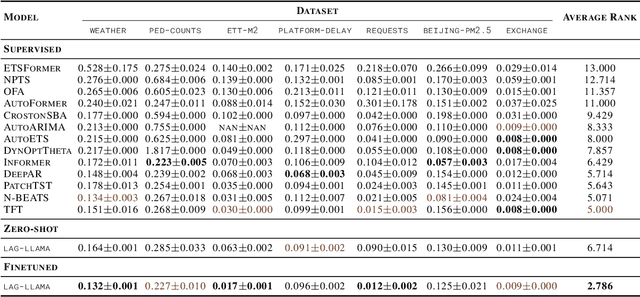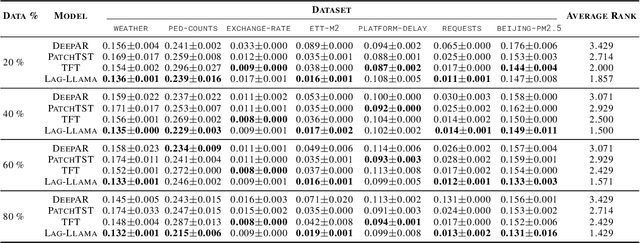Anderson Schneider
SAS: Simulated Attention Score
Jul 10, 2025Abstract:The attention mechanism is a core component of the Transformer architecture. Various methods have been developed to compute attention scores, including multi-head attention (MHA), multi-query attention, group-query attention and so on. We further analyze the MHA and observe that its performance improves as the number of attention heads increases, provided the hidden size per head remains sufficiently large. Therefore, increasing both the head count and hidden size per head with minimal parameter overhead can lead to significant performance gains at a low cost. Motivated by this insight, we introduce Simulated Attention Score (SAS), which maintains a compact model size while simulating a larger number of attention heads and hidden feature dimension per head. This is achieved by projecting a low-dimensional head representation into a higher-dimensional space, effectively increasing attention capacity without increasing parameter count. Beyond the head representations, we further extend the simulation approach to feature dimension of the key and query embeddings, enhancing expressiveness by mimicking the behavior of a larger model while preserving the original model size. To control the parameter cost, we also propose Parameter-Efficient Attention Aggregation (PEAA). Comprehensive experiments on a variety of datasets and tasks demonstrate the effectiveness of the proposed SAS method, achieving significant improvements over different attention variants.
Multi-modal Time Series Analysis: A Tutorial and Survey
Mar 17, 2025Abstract:Multi-modal time series analysis has recently emerged as a prominent research area in data mining, driven by the increasing availability of diverse data modalities, such as text, images, and structured tabular data from real-world sources. However, effective analysis of multi-modal time series is hindered by data heterogeneity, modality gap, misalignment, and inherent noise. Recent advancements in multi-modal time series methods have exploited the multi-modal context via cross-modal interactions based on deep learning methods, significantly enhancing various downstream tasks. In this tutorial and survey, we present a systematic and up-to-date overview of multi-modal time series datasets and methods. We first state the existing challenges of multi-modal time series analysis and our motivations, with a brief introduction of preliminaries. Then, we summarize the general pipeline and categorize existing methods through a unified cross-modal interaction framework encompassing fusion, alignment, and transference at different levels (\textit{i.e.}, input, intermediate, output), where key concepts and ideas are highlighted. We also discuss the real-world applications of multi-modal analysis for both standard and spatial time series, tailored to general and specific domains. Finally, we discuss future research directions to help practitioners explore and exploit multi-modal time series. The up-to-date resources are provided in the GitHub repository: https://github.com/UConn-DSIS/Multi-modal-Time-Series-Analysis
Privacy Amplification by Structured Subsampling for Deep Differentially Private Time Series Forecasting
Feb 04, 2025Abstract:Many forms of sensitive data, such as web traffic, mobility data, or hospital occupancy, are inherently sequential. The standard method for training machine learning models while ensuring privacy for units of sensitive information, such as individual hospital visits, is differentially private stochastic gradient descent (DP-SGD). However, we observe in this work that the formal guarantees of DP-SGD are incompatible with timeseries-specific tasks like forecasting, since they rely on the privacy amplification attained by training on small, unstructured batches sampled from an unstructured dataset. In contrast, batches for forecasting are generated by (1) sampling sequentially structured time series from a dataset, (2) sampling contiguous subsequences from these series, and (3) partitioning them into context and ground-truth forecast windows. We theoretically analyze the privacy amplification attained by this structured subsampling to enable the training of forecasting models with sound and tight event- and user-level privacy guarantees. Towards more private models, we additionally prove how data augmentation amplifies privacy in self-supervised training of sequence models. Our empirical evaluation demonstrates that amplification by structured subsampling enables the training of forecasting models with strong formal privacy guarantees.
Reweighting Improves Conditional Risk Bounds
Jan 04, 2025


Abstract:In this work, we study the weighted empirical risk minimization (weighted ERM) schema, in which an additional data-dependent weight function is incorporated when the empirical risk function is being minimized. We show that under a general ``balanceable" Bernstein condition, one can design a weighted ERM estimator to achieve superior performance in certain sub-regions over the one obtained from standard ERM, and the superiority manifests itself through a data-dependent constant term in the error bound. These sub-regions correspond to large-margin ones in classification settings and low-variance ones in heteroscedastic regression settings, respectively. Our findings are supported by evidence from synthetic data experiments.
Recurrent Interpolants for Probabilistic Time Series Prediction
Sep 18, 2024



Abstract:Sequential models such as recurrent neural networks or transformer-based models became \textit{de facto} tools for multivariate time series forecasting in a probabilistic fashion, with applications to a wide range of datasets, such as finance, biology, medicine, etc. Despite their adeptness in capturing dependencies, assessing prediction uncertainty, and efficiency in training, challenges emerge in modeling high-dimensional complex distributions and cross-feature dependencies. To tackle these issues, recent works delve into generative modeling by employing diffusion or flow-based models. Notably, the integration of stochastic differential equations or probability flow successfully extends these methods to probabilistic time series imputation and forecasting. However, scalability issues necessitate a computational-friendly framework for large-scale generative model-based predictions. This work proposes a novel approach by blending the computational efficiency of recurrent neural networks with the high-quality probabilistic modeling of the diffusion model, which addresses challenges and advances generative models' application in time series forecasting. Our method relies on the foundation of stochastic interpolants and the extension to a broader conditional generation framework with additional control features, offering insights for future developments in this dynamic field.
Deep Generative Sampling in the Dual Divergence Space: A Data-efficient & Interpretative Approach for Generative AI
Apr 10, 2024



Abstract:Building on the remarkable achievements in generative sampling of natural images, we propose an innovative challenge, potentially overly ambitious, which involves generating samples of entire multivariate time series that resemble images. However, the statistical challenge lies in the small sample size, sometimes consisting of a few hundred subjects. This issue is especially problematic for deep generative models that follow the conventional approach of generating samples from a canonical distribution and then decoding or denoising them to match the true data distribution. In contrast, our method is grounded in information theory and aims to implicitly characterize the distribution of images, particularly the (global and local) dependency structure between pixels. We achieve this by empirically estimating its KL-divergence in the dual form with respect to the respective marginal distribution. This enables us to perform generative sampling directly in the optimized 1-D dual divergence space. Specifically, in the dual space, training samples representing the data distribution are embedded in the form of various clusters between two end points. In theory, any sample embedded between those two end points is in-distribution w.r.t. the data distribution. Our key idea for generating novel samples of images is to interpolate between the clusters via a walk as per gradients of the dual function w.r.t. the data dimensions. In addition to the data efficiency gained from direct sampling, we propose an algorithm that offers a significant reduction in sample complexity for estimating the divergence of the data distribution with respect to the marginal distribution. We provide strong theoretical guarantees along with an extensive empirical evaluation using many real-world datasets from diverse domains, establishing the superiority of our approach w.r.t. state-of-the-art deep learning methods.
$\textbf{S}^2$IP-LLM: Semantic Space Informed Prompt Learning with LLM for Time Series Forecasting
Mar 09, 2024



Abstract:Recently, there has been a growing interest in leveraging pre-trained large language models (LLMs) for various time series applications. However, the semantic space of LLMs, established through the pre-training, is still underexplored and may help yield more distinctive and informative representations to facilitate time series forecasting. To this end, we propose Semantic Space Informed Prompt learning with LLM ($S^2$IP-LLM) to align the pre-trained semantic space with time series embeddings space and perform time series forecasting based on learned prompts from the joint space. We first design a tokenization module tailored for cross-modality alignment, which explicitly concatenates patches of decomposed time series components to create embeddings that effectively encode the temporal dynamics. Next, we leverage the pre-trained word token embeddings to derive semantic anchors and align selected anchors with time series embeddings by maximizing the cosine similarity in the joint space. This way, $S^2$IP-LLM can retrieve relevant semantic anchors as prompts to provide strong indicators (context) for time series that exhibit different temporal dynamics. With thorough empirical studies on multiple benchmark datasets, we demonstrate that the proposed $S^2$IP-LLM can achieve superior forecasting performance over state-of-the-art baselines. Furthermore, our ablation studies and visualizations verify the necessity of prompt learning informed by semantic space.
Structural Knowledge Informed Continual Multivariate Time Series Forecasting
Feb 20, 2024



Abstract:Recent studies in multivariate time series (MTS) forecasting reveal that explicitly modeling the hidden dependencies among different time series can yield promising forecasting performance and reliable explanations. However, modeling variable dependencies remains underexplored when MTS is continuously accumulated under different regimes (stages). Due to the potential distribution and dependency disparities, the underlying model may encounter the catastrophic forgetting problem, i.e., it is challenging to memorize and infer different types of variable dependencies across different regimes while maintaining forecasting performance. To address this issue, we propose a novel Structural Knowledge Informed Continual Learning (SKI-CL) framework to perform MTS forecasting within a continual learning paradigm, which leverages structural knowledge to steer the forecasting model toward identifying and adapting to different regimes, and selects representative MTS samples from each regime for memory replay. Specifically, we develop a forecasting model based on graph structure learning, where a consistency regularization scheme is imposed between the learned variable dependencies and the structural knowledge while optimizing the forecasting objective over the MTS data. As such, MTS representations learned in each regime are associated with distinct structural knowledge, which helps the model memorize a variety of conceivable scenarios and results in accurate forecasts in the continual learning context. Meanwhile, we develop a representation-matching memory replay scheme that maximizes the temporal coverage of MTS data to efficiently preserve the underlying temporal dynamics and dependency structures of each regime. Thorough empirical studies on synthetic and real-world benchmarks validate SKI-CL's efficacy and advantages over the state-of-the-art for continual MTS forecasting tasks.
Empowering Time Series Analysis with Large Language Models: A Survey
Feb 05, 2024Abstract:Recently, remarkable progress has been made over large language models (LLMs), demonstrating their unprecedented capability in varieties of natural language tasks. However, completely training a large general-purpose model from the scratch is challenging for time series analysis, due to the large volumes and varieties of time series data, as well as the non-stationarity that leads to concept drift impeding continuous model adaptation and re-training. Recent advances have shown that pre-trained LLMs can be exploited to capture complex dependencies in time series data and facilitate various applications. In this survey, we provide a systematic overview of existing methods that leverage LLMs for time series analysis. Specifically, we first state the challenges and motivations of applying language models in the context of time series as well as brief preliminaries of LLMs. Next, we summarize the general pipeline for LLM-based time series analysis, categorize existing methods into different groups (i.e., direct query, tokenization, prompt design, fine-tune, and model integration), and highlight the key ideas within each group. We also discuss the applications of LLMs for both general and spatial-temporal time series data, tailored to specific domains. Finally, we thoroughly discuss future research opportunities to empower time series analysis with LLMs.
Lag-Llama: Towards Foundation Models for Time Series Forecasting
Oct 12, 2023



Abstract:Aiming to build foundation models for time-series forecasting and study their scaling behavior, we present here our work-in-progress on Lag-Llama, a general-purpose univariate probabilistic time-series forecasting model trained on a large collection of time-series data. The model shows good zero-shot prediction capabilities on unseen "out-of-distribution" time-series datasets, outperforming supervised baselines. We use smoothly broken power-laws to fit and predict model scaling behavior. The open source code is made available at https://github.com/kashif/pytorch-transformer-ts.
 Add to Chrome
Add to Chrome Add to Firefox
Add to Firefox Add to Edge
Add to Edge